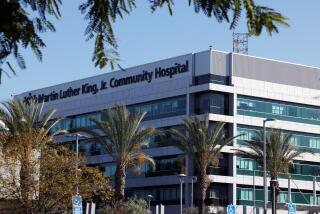Director of Healthcare to Retire
- Share via
Pierre Durand, the architect of Ventura County’s modern healthcare system, announced his retirement Monday, capping two decades during which he saved a struggling county hospital, created a broad safety net of clinics for the poor and survived a fierce battle for patients with Community Memorial Hospital in Ventura.
Durand, 58, said he will leave his job as director of the Health Care Agency in March on a high note -- after reopening Santa Paula’s shuttered medical center as a second public hospital and while implementing an expansion of county mental health services.
Ventura is one of a handful of California counties that still has a public hospital. Durand also created a system of 43 clinics serving 1.2 million patients a year.
“He’s just a master,” said Kathy Long, chairwoman of the county Board of Supervisors. “He saved a healthcare system that wasn’t a system at all until he took over.”
Samuel Edwards, who ran the county hospital after Durand’s promotion to agency director in 1995, said Durand’s accomplishments may be unique in California. He was a statewide leader in showing how counties could nearly break even on poverty medicine, Edwards said.
“Our residents now have access to public health services that are unmatched in the other 57 counties,” Edwards said.
The county has clinics in its eight largest cities, steering needy residents away from costly care in the county hospital’s emergency room.
Durand announced his departure in short notes to the Board of Supervisors and his staff.
“There’s never a good time to leave,” he said in an interview. “But the longer we stay with what we know, the less time we have left to do something else.”
Durand, who is leaving a $190,000-a-year job, said he will travel the seven continents, then probably work as a consultant.
Under Durand’s direction, the county health system greatly expanded, even offering treatment to thousands of county employees and their families at a reduced cost. That prompted a war between the county facility and Community Memorial Hospital, its private neighbor two blocks away.
Community Memorial complained that the county’s aggressive posture amounted to unfair competition for privately insured patients by a public entity. The private hospital spent $1.6 million on a successful ballot initiative to block construction of a $51-million wing to the county hospital in 1996.
That dispute is history, said Community Memorial President Gary Wilde, who was hired partly to resolve past differences with the county.
“We’re working cooperatively,” Wilde said, because Durand agreed not to compete for private patients beyond county employee’s families. The private hospital no longer opposes construction of the new county hospital wing, and county supervisors recently approved its being built.
Durand said he’s still bothered by another controversy. In the late ‘90s, he was a central figure in a fight over who should control county mental health services -- his agency or social service officials. During the turmoil, the county made reporting mistakes that led to repayment of $15 million in state and federal money and prompted the departure of the county’s top mental health officials.
Durand is uniformly praised for saving the county hospital in the mid-1980s. Then chief deputy auditor, he used his financial expertise to help erase $38 million in hospital debt. He helped devise a plan for laying off 200 of the hospital’s 1,200 employees and shifted most care for the poor to an emerging system of neighborhood clinics.
The clinics were far removed from the old model of public care: They were semiprivate providers, operated by private physicians. The doctors held contracts with the county but hired their own staff members, billed patients themselves and controlled costs.
The doctors could not turn anyone away, but they reaped economic advantages in return. If they reduced red ink, they could keep part of the savings.
The system increased the county’s Medi-Cal and Medicare billings. Before Durand’s reforms, the county’s subsidy to the public hospital was $10 million annually. Today it is about $5.5 million.
Ventura County Supervisor Judy Mikels said Durand will be missed.
“His impact was monumental,” she said. “People think of hospitals in a warm and fuzzy way. But the industry is cutthroat. Marcus Welby died a long time ago. And without Pierre’s cunning and number-crunching, we wouldn’t have survived.”
More to Read
Sign up for Essential California
The most important California stories and recommendations in your inbox every morning.
You may occasionally receive promotional content from the Los Angeles Times.













